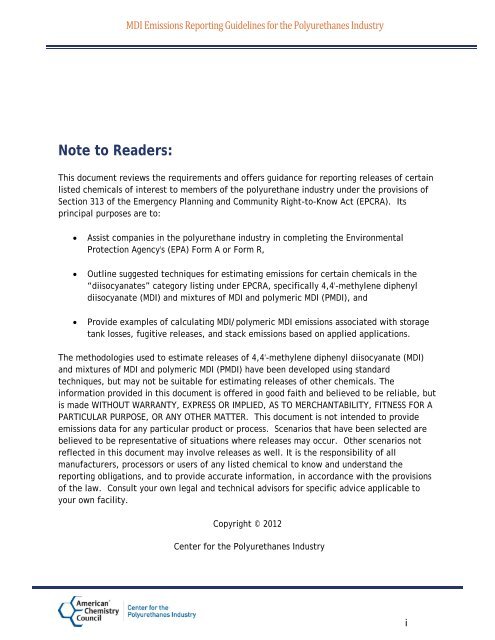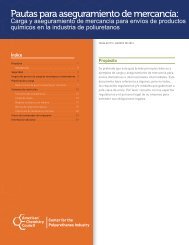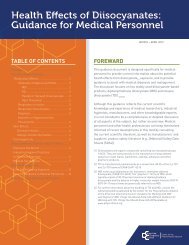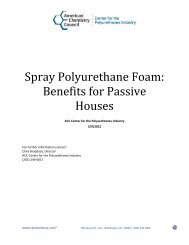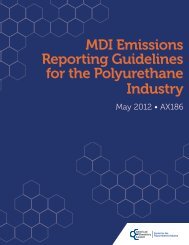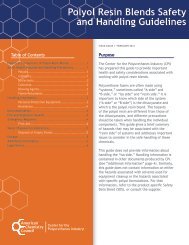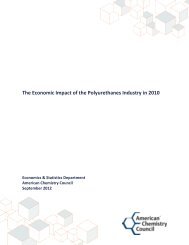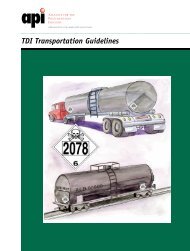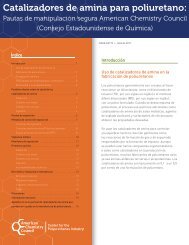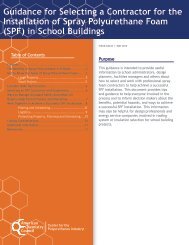MDI Emissions Reporting Guidelines for the ... - Polyurethanes
MDI Emissions Reporting Guidelines for the ... - Polyurethanes
MDI Emissions Reporting Guidelines for the ... - Polyurethanes
You also want an ePaper? Increase the reach of your titles
YUMPU automatically turns print PDFs into web optimized ePapers that Google loves.
Note to Readers:<br />
<strong>MDI</strong> <strong>Emissions</strong> <strong>Reporting</strong> <strong>Guidelines</strong> <strong>for</strong> <strong>the</strong> <strong>Polyurethanes</strong> Industry<br />
This document reviews <strong>the</strong> requirements and offers guidance <strong>for</strong> reporting releases of certain<br />
listed chemicals of interest to members of <strong>the</strong> polyurethane industry under <strong>the</strong> provisions of<br />
Section 313 of <strong>the</strong> Emergency Planning and Community Right-to-Know Act (EPCRA). Its<br />
principal purposes are to:<br />
Assist companies in <strong>the</strong> polyurethane industry in completing <strong>the</strong> Environmental<br />
Protection Agency's (EPA) Form A or Form R,<br />
Outline suggested techniques <strong>for</strong> estimating emissions <strong>for</strong> certain chemicals in <strong>the</strong><br />
“diisocyanates” category listing under EPCRA, specifically 4,4'-methylene diphenyl<br />
diisocyanate (<strong>MDI</strong>) and mixtures of <strong>MDI</strong> and polymeric <strong>MDI</strong> (P<strong>MDI</strong>), and<br />
Provide examples of calculating <strong>MDI</strong>/polymeric <strong>MDI</strong> emissions associated with storage<br />
tank losses, fugitive releases, and stack emissions based on applied applications.<br />
The methodologies used to estimate releases of 4,4'-methylene diphenyl diisocyanate (<strong>MDI</strong>)<br />
and mixtures of <strong>MDI</strong> and polymeric <strong>MDI</strong> (P<strong>MDI</strong>) have been developed using standard<br />
techniques, but may not be suitable <strong>for</strong> estimating releases of o<strong>the</strong>r chemicals. The<br />
in<strong>for</strong>mation provided in this document is offered in good faith and believed to be reliable, but<br />
is made WITHOUT WARRANTY, EXPRESS OR IMPLIED, AS TO MERCHANTABILITY, FITNESS FOR A<br />
PARTICULAR PURPOSE, OR ANY OTHER MATTER. This document is not intended to provide<br />
emissions data <strong>for</strong> any particular product or process. Scenarios that have been selected are<br />
believed to be representative of situations where releases may occur. O<strong>the</strong>r scenarios not<br />
reflected in this document may involve releases as well. It is <strong>the</strong> responsibility of all<br />
manufacturers, processors or users of any listed chemical to know and understand <strong>the</strong><br />
reporting obligations, and to provide accurate in<strong>for</strong>mation, in accordance with <strong>the</strong> provisions<br />
of <strong>the</strong> law. Consult your own legal and technical advisors <strong>for</strong> specific advice applicable to<br />
your own facility.<br />
Copyright © 2012<br />
Center <strong>for</strong> <strong>the</strong> <strong>Polyurethanes</strong> Industry<br />
i


